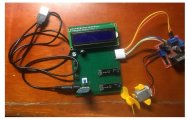基于手势识别的风扇智能控制系统设计(任务书,开题报告,论文说明书15000字,电路图,程序代码,元器件清单,答辩PPT)
摘要
随着社会和经济的发展,主打便捷和实用功能的智能家居逐步进入人们的视线。近二十年来科技水平提升也使得智能家居产业在我国迅速得到发展,许多科技公司也加入到了智能家居市场的争夺中。本文主要研究了智能家居中智能风扇的系统控制设计,提出了基于手势识别的全新方案。
传统风扇的控制器一般都是在风扇机体上,人们必须在风扇机体上手动控制才能实现风扇的开关控制和调速控制,这种控制方法在智能时代的今天不能被人们所接受。基于当前智能家居时代的发展背景,本论文设计了一款基于STC89C52单片机的手势及手机蓝牙控制的智能风扇。通过在风扇上安装红外传感器来识别手势,智能风扇控制系统通过识别手势后进而识别人类行为对风扇进行智能控制,增加了风扇的智能人机交互性,这为日后智能家居研究中的情景化设计提供全新的思路。同时风扇也能根据安装在单片机系统上的温度传感器所测温度进行PWM无级调速,单片机系统上安装的蓝牙模块,能实现手机设备与智能风扇设备的互联,并且可以通过安装手机蓝牙app进行控制智能风扇。本论文研究的智能风扇设计方便快捷,在日常生活中具备广泛的用途,对智能家居的普及具有一定的指导意义,因此本设计具有极大的研究价值。
关键词:智能风扇;手势识别;STC89C52;无线蓝牙
Abstract
With the development of society and economy, smart homes with convenient and practical functions have gradually entered people's sights. The improvement of science and technology in the past two decades has also enabled the smart home industry to develop rapidly in China, and many technology companies have joined the competition in the smart home market. This paper mainly studies the system control design of smart fan in smart home, and proposes a new scheme based on gesture recognition.
The controllers of the traditional fans are generally on the fan body. People must manually control the fan body to realize the switch control and speed control of the fan. This control method cannot be accepted by people in the intelligent era today. Based on the development background of the current smart home era, this paper designs a smart fan based on STC89C52 single-chip gesture and Bluetooth control of mobile phone. By installing an infrared sensor on the fan to recognize the gesture, the intelligent fan control system intelligently controls the fan by recognizing the gesture and then recognizing the human behavior, thereby increasing the intelligent human-computer interaction of the fan, which is a contextual design in the future smart home research. Provide new ideas. At the same time, the fan can also perform PWM stepless speed regulation according to the temperature measured by the temperature sensor installed on the single chip system. The Bluetooth module installed on the single chip system can realize the interconnection of the mobile phone device and the smart fan device, and can be installed by installing the mobile phone Bluetooth app. Control the smart fan. The intelligent fan designed in this thesis is convenient and quick to design, has a wide range of uses in daily life, and has certain guiding significance for the popularization of smart home. Therefore, this design has great research value.
Key Words:Gesture Recognition;Smart Fan;STC89C52;Wireless Bluetooth
论文主要研究内容
本文开篇先对近年来智能家居的发展现状做了概述,探讨了未来智能家居市场的发展可行性。本文通过对上述智能家居系统的分析,结合智能家居现阶段以发展智能家居设备单品的内容,提出了一套全新的以手势识别蓝牙app控制为创新点的智能风扇控制系统设计,本系统设计主要实现了三个功能来控制风扇电机,分别是手势控制、蓝牙控制和根据室温自动控制等。
本论文的结构分为六章,依次是:
第一章为绪论,概述了智能家居市场的起源和现状以及智能家居市场发展的未来趋势。
第二章介绍了手势识别的智能风扇系统的整体系统方案设计的选择,还介绍了设计方案的零部件选取论证。
第三章主要介绍了手势识别的智能风扇系统各零部件模块工作原理和电路的设计。
第四章主要介绍了手势识别的智能风扇系统控制编程软件的选取和各零部件模块的软件编程流程图。
第五章介绍了本次设计的应用实例分析、电路连接的实物模型和实物测试流程等。
第六章介绍了本次研究设计的结论,并对未来智能家居的发展做出了展望。
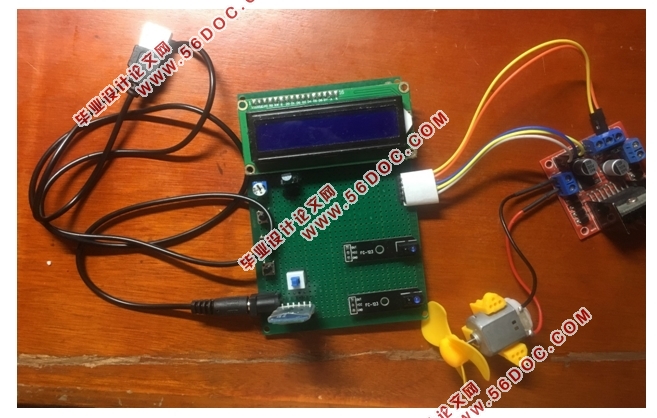
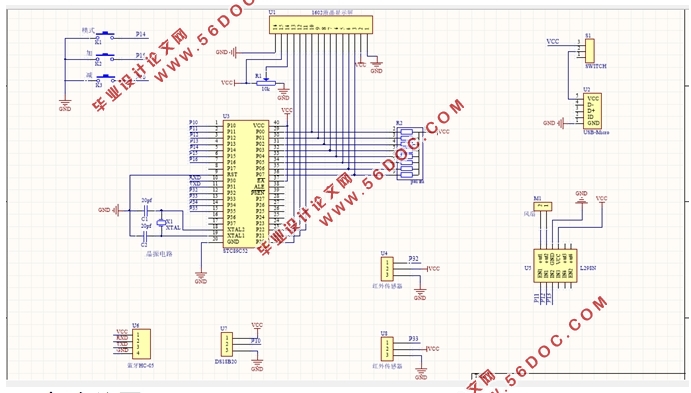
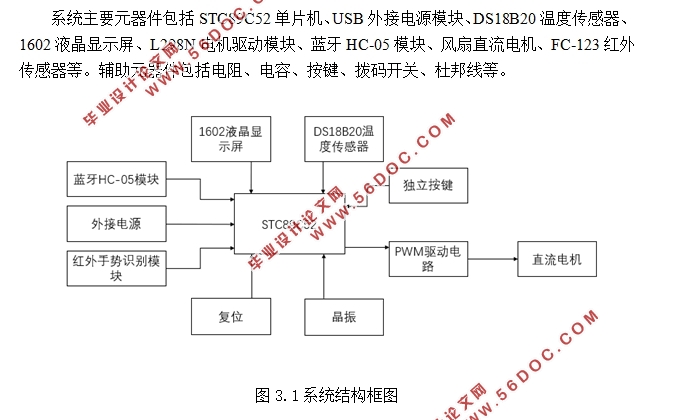
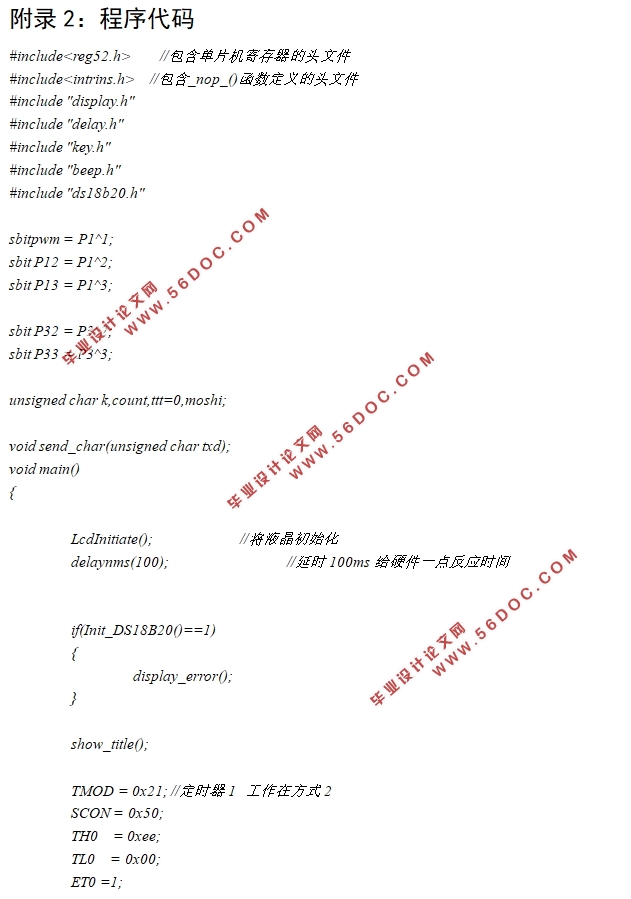
目录
第1章绪论 1
1.1 研究背景 1
1.2 研究目的及意义 1
1.3国内外研究现状 2
1.4论文主要研究内容 3
第2章手势识别智能风扇系统整体方案设计 4
2.1 手势识别智能风扇系统整体的设计 4
2.2 零部件选取的方案论证 4
2.2.1 单片机芯片的选择 4
2.2.2 无线遥控模块的选择 5
2.2.3 温度传感器的选择 5
2.2.4 显示器件的选择 6
2.2.5 调速方式的选择 6
2.2.6 手势识别传感器的选择 6
第3章手势识别智能风扇系统硬件电路设计 8
3.1 主控单片机电路设计 8
3.1.1 STC89C52单片机简介 8
3.1.2 STC89C52单片机最小系统 9
3.1.3 STC89C52中断技术概述 10
3.2 DS18B20温度采集电路设计 11
3.2.1 DS18B20的结构特点 11
3.2.2 DS18B20的工作原理和工作电路 12
3.3 USB外接电源模块电路设计 13
3.4 HC-05蓝牙模块电路设计 14
3.5 独立按键电路设计 14
3.6 1602液晶显示屏电路设计 15
3.7 电机风扇驱动和调速电路 15
3.8 FC-123红外传感器电路设计 16
3.9 电路总图 17
第4章手势识别的智能风扇系统软件设计 19
4.1 编程语言和编程软件的选择 19
4.1.1 编程语言的选择 19
4.1.2 编程软件的选择 19
4.2 主程序设计 20
4.3 DS18B20温度传感器子程序设计 21
4.4 1602液晶显示子程序设计 22
4.5 独立按键子程序设计 23
4.6 蓝牙模块子程序设计 24
4.7 红外感应模块子程序设计 25
4.8 L298N电机驱动模块子程序设计 27
第5章应用实例与分析 29
5.1 电路连接实物模型 29
5.2 测试流程分析 30
第6章结论与展望 31
参考文献 32
致谢 33
附录 34
附录1:电路总图 34
附录2:程序代码 34
|
